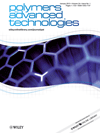Aging properties and mechanism of the modified asphalt by packaging waste polyethylene and waste rubber powder
Abstract
For the consideration of the environmental and economic issues, retrieved packaging waste polyethylene and waste rubber powder were selected as modifiers to modify the ordinary oil asphalt, and the rotating film oven test was adopted to study the aging process of the modified asphalt. The results showed that the performance of the modified asphalt deteriorated, as indicated by the increase in the softening point and the reduced ductility and penetration. However, compared with nonmodified asphalt, the rangeability of the performance indicators of the modified asphalt before and after aging became narrow, indicating that the aging properties of the modified asphalt were improved. In the modified asphalt system, the swelling of the polymer modifiers was caused by the absorption of the light components of the asphalt, thereby reducing the formation of asphaltenes in the aging process. The polymer modifiers absorb the light oil of the asphalt, which can reduce the content of free radicals and improve the aging properties of the asphalt. In addition, the waste rubber power containing antioxidants and anti-ozone agents effectively improves the antiaging properties of the asphalt. Copyright © 2012 John Wiley & Sons, Ltd.




